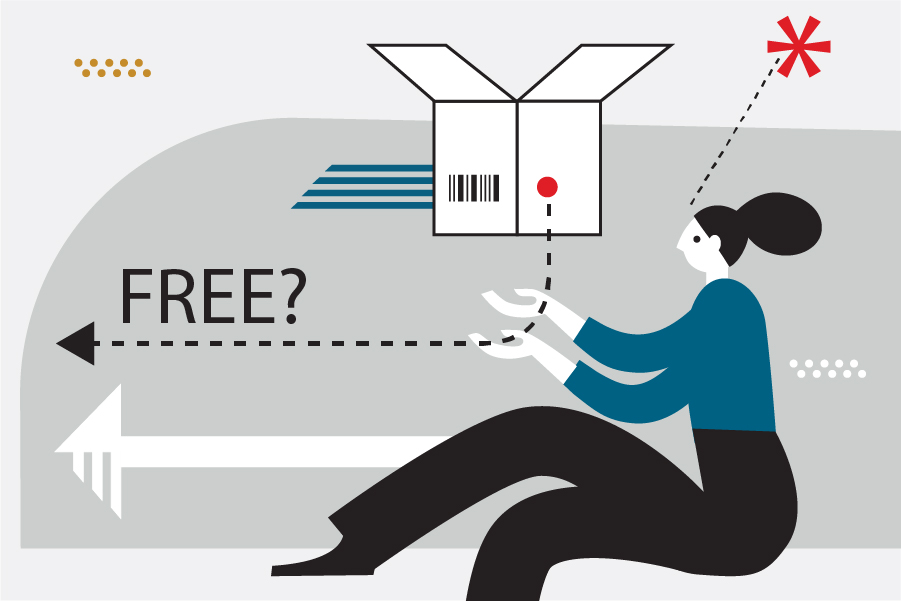Offering free shipping often feels like a black-and-white issue for ecommerce merchants
In this post, we’re going to cover:
- The pros and cons of offering free returns shipping
- What merchants need to consider before offering free returns shipping
- How merchants can offer free returns shipping and maintain profitability
How is free returns shipping different from free returns?
‘Free returns’ and ‘free return shipping’ are often used interchangeably by retailers in their marketing collateral. However, they aren’t always talking about the same thing.
‘Free returns’ simply means that a retailer is not charging customers for making a return in the form of restocking fees. These are sometimes used to cover the cost of reconditioning or repackaging a product to get it ready for resale. However, the push towards hassle-free returns has made restocking fees increasingly unpopular in recent years.
Free returns shipping is exactly what it sounds like; a retailer covering the cost of customers shipping returned items to their warehouse or distribution center.
Why do customers want free return shipping?
It's no secret why consumers love free return shipping. Purchasing goods without getting to test or try them first is always a risk, especially when you're buying from a vendor for the first time. Paying for return shipping adds a huge amount of friction to the returns experience, not to mention the logistics of sourcing return packaging and finding time to get to the post office. In Baymard's recent survey that asked U.S. adults about their reasons for cart abandonment, 48% cited extra costs such as shipping.
Free return shipping policies provide reassurance to customers that they won't get penalized for receiving a damaged product, or for discovering that the product doesn’t fit the imagery they saw online. It's an acknowledgment that buying online is often difficult - and that the merchant will support you to fix the problem.
Offering free return shipping also has major benefits for retailers. Consumers overwhelmingly prefer to support merchants with generous return policies, while a seamless and easy returns process makes them much more likely to shop again with a brand in the future.
Moreover, there’s the simple fact that more merchants than ever are offering free returns shipping; if you opt out, there’s no shortage of brands ready to entice your customers away.
But return shipping costs can be a huge financial burden for online sellers. If merchants aren’t careful, the price of offering free return shipping can end up outweighing the benefits.
How free returns shipping can damage your ecommerce business
Free returns shipping can fuel returns fraud
While free return shipping might increase conversions, you could land your business with a variety of additional costs that erode the benefits of new customers.
Charging for return shipping is one of the easiest ways for merchants to combat returns fraud, as paying for shipping makes the return process a lot less convenient for customers. Returns fraud is booming in the wake of the pandemic, with lost merchandise set to surpass $20 billion in 2021 - an 18% jump over last year.
Free returns shipping can be an open invitation for customers to engage in practices like bracketing, also referred to as ‘try before you buy,’ where customers buy multiple size/color variations to try at home to return at a later date. In addition to increasing your shipping costs, these kinds of practices also play havoc with your inventory levels.
Peak season surcharges will sting big time during the holidays
While shouldering return shipping costs might be manageable during most of the year, you shouldn’t fall into the trap of ignoring peak season surcharges. These are temporary surcharges that parcel carriers add on top of their base rates to cover higher operational costs when networks are at or close to capacity.
Peak season surcharges can be applied to any kind of parcel. But they’re most common for deliveries that are the least efficient for carriers, such as residential delivery and oversized/heavy items. This means you can end up paying as much as $5 extra per returned package, which can easily derail your profits during the holiday season.
It becomes an expectation
Retailers need to think carefully about the merits of introducing a new service offering, whether that’s free return shipping or a payment method like Buy Now, Pay Later. Because once the genie is out of the bottle, it’s very difficult to put it back in.
When customers have gotten used to a certain standard of service, it’s difficult to wind this back without seriously disappointing your customers. This can be perceived as your business trying to make higher profits at the expense of the customer experience, which could cause your churn rate to increase.
In sum, free returns shipping isn’t something your business can easily trial for a limited time to see how it goes. Once you’ve introduced it, customers will expect it to stay.
What to consider when offering free return shipping
There are a few different ways you can optimize your return shipping policy to keep costs down and encourage positive return behavior.
But before we cover this, it’s important to bear in mind that offering free return shipping isn’t going to affect all merchants equally. Some ecommerce businesses will incur relatively minor costs, while for others it’s simply unaffordable. This depends on a variety of factors, that you’ll need to take into account before formulating your policy, including:
Are you paying for outbound shipping?
This might seem like a silly question. But whether you’re paying shipping costs both ways has a major influence on the impact of free returns shipping on your business.
There are very few cases where a merchant pays for return shipping but has the customer pay to receive their order. After all, it makes little sense to back-load rather than front-load customer incentives to purchase.
So, it’s safe to assume that if you’re considering whether or not to offer free return shipping, you’re probably already paying to ship outbound orders. This means you need to consider the financial impact on your business if you’re paying twice to ship a portion of your orders.
What kinds of products are you shipping?
The size of your overall shipping costs will mostly be determined by the size and weight of the goods you’re selling. For example, apparel tends to be lightweight and can be easily folded down to achieve a lower DIM weight, which is why many fashion retailers can offer free return shipping without an issue.
However, the same can’t be done with furniture or gym equipment. If all or some of your product catalog includes oversized and/or heavy items, the cost of return shipping is likely to set back your profits considerably.
What is your ecommerce returns policy?
How strict or lax your ecommerce return policy plays a big role in many returns your business is likely to process (and pay for).
If you market a ‘hassle-free returns policy where consumers are free to return times due to change of mind, you’re effectively signing up to pay for return shipping very frequently.
But if you only allow for returns in the event of a damaged or defective product, return shipping costs are going to be pretty minimal for your business. Offering to pay for shipping in the event of situations like this is an excellent way to recover customer goodwill and mend damaged relationships.
Does your business commonly use split shipments?
Split shipments often occur when the items included in a customer’s order are being stored in separate facilities. Rather than sending an item to another facility and delaying fulfillment, most merchants will send them to the customer as separate packages. The biggest downside of split shipments is that the more times an order is split, the more expensive shipping and fulfillment becomes.
If a lack of demand forecasting or inventory visibility causes you to use split shipments frequently, you need to consider the additional impact of return shipping costs. Depending on the size of an order and how many times it’s being split, you could easily end up paying for shipping three or four times over.
Moreover, if there’s a sizable gap between split shipments arriving, a customer may decide to return an item before the rest of their order arrives. This can result in returned items being shipped separately back to your warehouse rather than together, meaning the cost of return shipping will quickly mount.
How to create a sustainable free return shipping policy
It’s important to note that free return shipping doesn’t have to be an all-or-nothing policy. Instead of seeing it as a race to the bottom, try to think of situations where offering free return shipping would be beneficial to your business - and where it would best be avoided.
Here are a few ways that your ecommerce business can segment your free return shipping policy:
1. Exclude certain circumstances from free return shipping
The impact of free returns shipping will vary depending on a variety of factors, such as the size of the item and the time of year it’s being shipped. It makes little sense not to account for this in how you approach free return shipping.
Free returns shipping during the holiday season might be a great marketing tool - but you’re going to pay dearly for it. As we mentioned above, peak season surcharges add considerably to the cost of shipping packages at this time of year - and shouldering the burden both ways is unlikely to be sustainable for your business.
Here are some other situations you should consider excluding from free return shipping:
- Discounted/last unit items
- Expedited return services
- Oversize/heavy items
2. Factor the cost of return shipping into your free shipping threshold
Free shipping thresholds are a strategy that allows smaller merchants to meet consumer expectations for free shipping while still protecting their profit margins.
Best of all, free shipping thresholds help to boost AOV (Average Order Value) by incentivizing consumers to spend more to gain this perk; 93% of consumers will take action to qualify for free shipping at an online store, such as adding additional items to their shopping cart.
However, free shipping thresholds can backfire if you don’t take into account all of the costs that contribute to shipping and fulfilling an order. For example, if you decide to offer free shipping on both outbound orders and returns but your threshold only accounts for that initial journey, this could result in you making a loss on some orders.
By recalculating your free shipping threshold to account for the cost of return shipping, you can offer this service without worrying about the impact on your bottom line.
Head to our free shipping threshold guide to learn how to calculate your shipping threshold.
3. Only offer free return shipping on exchanged items
Most return policies don’t distinguish between a product being returned and one being exchanged - but there’s a world of difference to your business.
The number of orders refunded vs. exchanged is a powerful indicator of customer retention. A product exchange can mean many things; that a customer likes a product but needs a different variation of it. Or that a product isn’t right for their needs, but that they’re eager to support your brand over a competitor.
Exchanges are a retailer’s first line of defense to prevent revenue from slipping out the door. So, why penalize customers wanting to make exchanges by charging them for the privilege?
Offering free return shipping on exchanges only is a positive form of reinforcement that helps to shape customer behavior. It strikes a good middle-ground between having an overly restrictive return policy and one which encourages customers not to think too deeply about their reasons for returning.
When exchanges become the cheaper option, your refund rate is likely to drop considerably.
4. Offer free return shipping as a loyalty perk
Loyalty rewards and free shipping are a dream combination. Why? Because loyalty programs provide an easy way to segment your most loyal, high-spending customers.
By offering free return shipping to loyalty members who are in either a paid loyalty program or in a certain loyalty tier, you’re making it available to those who’ve already paid for this service. Interestingly, studies on return behavior show that the customers who return the most items are some of the most profitable.
Although this might seem counterintuitive, the reasoning is quite simple. While it’s easy to characterize these individuals as ‘serial returners’, they’re also serial buyers who keep returning to shop with you. So while they might end up returning a portion of each order each time, they’re still worth more to your business than a customer who returns nothing but only shops with you infrequently.
In sum, offering returns shipping to your most high-value customers is less about encouraging returns, and more about acknowledging their contribution to your business. Making it easier for this group to make returns also incentivizes other customers to up their spending to qualify for this perk.
Offering free returns shipping doesn’t have to mean eroding your profitability in order to keep up with competitors. By following one or more of the strategies outlined above, you can implement a sustainable free return shipping strategy that rewards high-value customers and incentivizes positive return behaviors that benefit your business.
For more about offering free shipping during the upcoming holiday season, check out our full guide.




